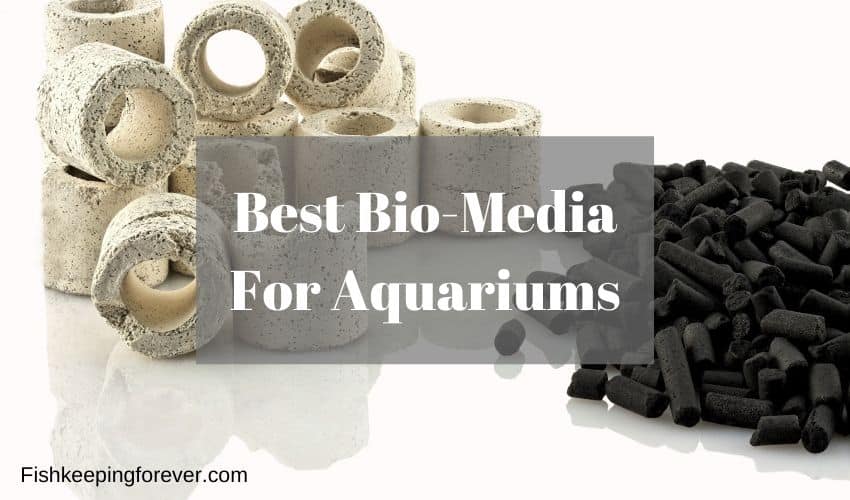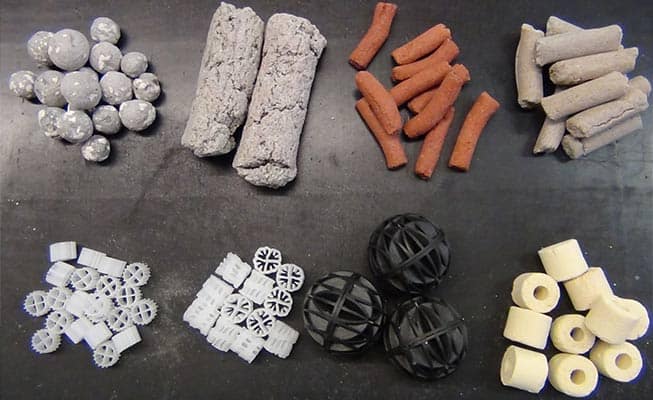Bio-media for fish tank filters has been in use for many years now. In our quest to discover the best aquarium bio-media for fish tank filters, we reviewed the top 5 within the bio-media category. Bio-media is not a new product. Most filters contain either physical filter material like sponge or filter floss and
That said, technology has improved over the years and you now need less media to obtain better results, This is thanks to the advances over the past few years in aquarium filter media.
Both types of filtration media play their part in keeping your aquarium clean and fish safe.
In this Best Aquarium Bio-Media for fish tank filters review, we’ll look at the Top 5 Aquarium Bio-Media available today which is perfect for both a HOB (hang on the back) filter and an external canister filter. Both use bio-media to keep aquarium water clean.
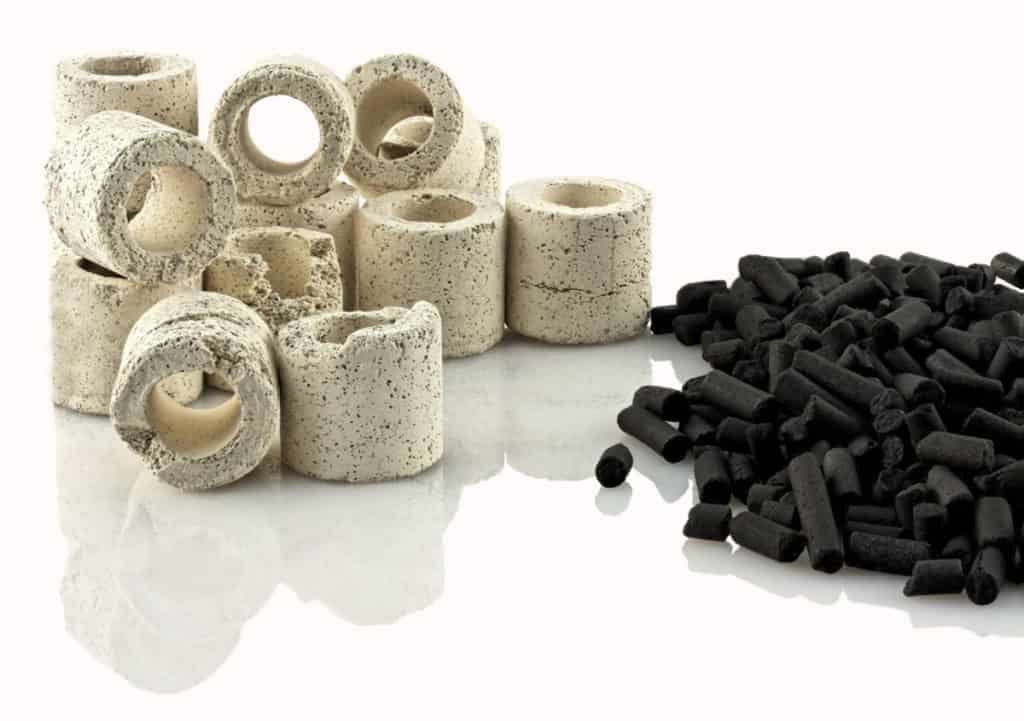


Table of Contents
Quick peek at our top picks…..
Types Of Filter Media
There are three main types of aquarium media:
- Chemical: Chemical filters work by removing toxic and unwanted chemicals as the water passes through a chemical media. Charcoal was a popular choice back in the day. Now, more modern materials are used which offer far better results. These are reviewed within this article.
- Biological: Friendly bacteria grow within this type of filter media and break down waste products into Ammonia. Ammonia is very toxic to all fish and is broken down into nitrites by an oxygen-loving bacteria known as Nitrosomonas. This process is called the Nitrogen cycle.
- Mechanical: Water passes through a type of filter media like filter floss, sponge and filter pads. These trap the waste, dirt and uneaten food within the media. This will then need to be physically removed by yourself every week or two.
What Is Aquarium Bio-Media?
Bio-media is made of a porous material that allows nitrifying bacteria to colonize. These helpful bacteria help break down waste products as part of the nitrogen cycle.
Modern aquarium bio-media for fish tank filters have the ability to establish a large number of bacteria in a small place. This makes bio-media perfect for small aquarium filters, it’s a high performing filter media.
There are many types of bio-media:
- Glass beads
- Plastic Rings
- Bio Balls
- Porous Rocks
- Polymer material
- Ceramic media
Best Bio-Media For Canister Filters
Fluval PreFilter Media
This Bio-Prefilter m
Most bio-media work in the opposite way. They need clean water running over them to work better.
On first inspection of this pre-bio-media product from Fluval, we found the size perfect for the first chamber of any external filter. They are the size of a dime which has a lot of surface area for bacteria to grow.
We found them easy to install and clean.
CNZ Aquarium Filter Media
There are lots of options to choose from with this product. We went with the double package as we were testing it in one of our larger external canister filters a Fluval FX6.
We were pleasantly surprised with the package we received:
- 1 lb of active carbon in one mesh media bag x 2
- 50 pieces of bio balls in one media bag x 2
- 500 g of ceramic rings in 1 filter media bag x 2
The diameter of the bio ball is
We found the media bags very helpful although they are not suited for all aquarium filters ie. smaller HOB filters. But that’s fine, you can simply remove the bio-media from the bags.
Keeping the bio-media in the bags made for an easier cleaning process. You simply remove the bag and wash it in a jug or bowl of your aquarium water to remove excess dirt and waste.
The bio-balls are not a premium product – you can tell from the way they are made – but for the price, they work just fine. Compare them to a product three times more expensive and they will stack up well against them. The only difference will be the life span of the product.
Marineland Canister Filter Ceramic Rings
Marineland
They are a quality ceramic and very porous material. We found colonies of bacteria on them really quickly.
We received around 140-150 pieces in the box which was fine for one layer in our larger canister filters and plenty for our smaller HOB filters.
If you have a larger filter like the Fluval FX6 I would suggest two boxes. You should only need to replace these if you break them. Otherwise, I suggest you change 75% of them after 18 Months. Never change all the media at once.
The only negative point with these was when we unpacked ours we found the product had manufacturing dust all over them. We needed to rinse them before we could use them. We also found some of them were stuck together as if the machine in manufacturing hadn’t cut them. It was simple enough to break them up as we added them to our Hang on the back filter.
Boxtech Bio Balls
We liked this product and I didn’t think we would when we first ordered them. They look to be very poorly made in the picture and not a premium product. We were wrong!
Made of
We simply dropped one of the mess bags in the middle section of our canister filter. With our HOB filter, we simply removed some of the bio-ball from the bag and dropped them in the filter chamber.
The difference between these and some other bio balls was that the inside of the ball was also a very important part of their performance. Most bio-balls just focus on the outer ball. These had an inner surface area perfect for anaerobic bacteria growth. Very impressed!
Biohome Ultimate Filter Media
This product is available in three different types. We tested the Ultimate Bio Media. The Biohome Ultimate Filter Media was one of the more expensive bio-media in our tests. But was it worth it?
This was our favorite from the start. The material is very porous and has a rough surface. This is perfect for bacteria to grow. All parts of this media have a role to play. The outer area supports aerobic bacteria and the inner part anaerobic bacteria.
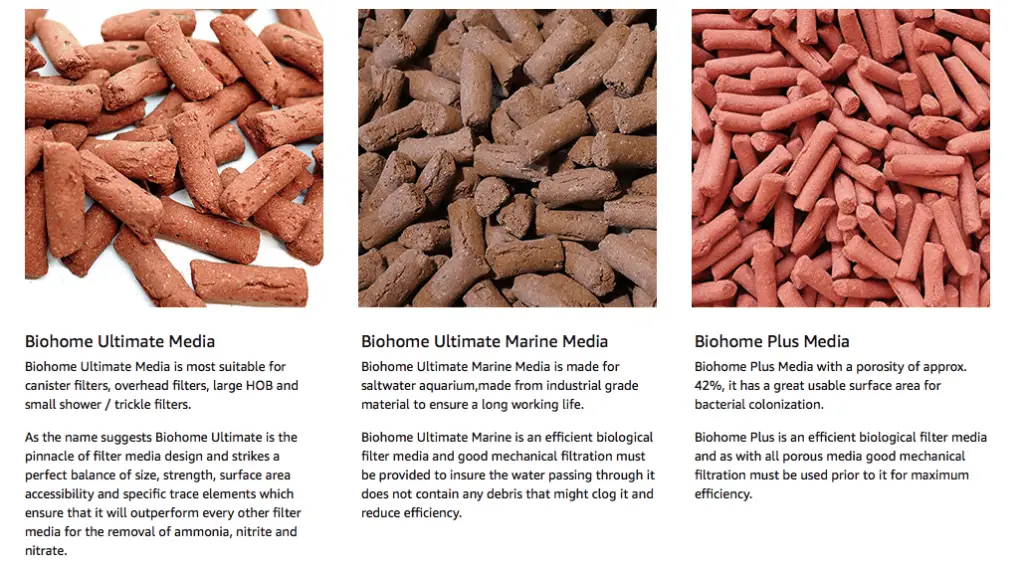
Both play a role in converting harmful nitrates and nitrites. We ordered the 1 lb bag which was the perfect amount for our filter. In a smaller HOB filter, you’ll only need to use half of that.
We read some reports on Amazon of this product making the water cloudy on first use. However, we can’t report any such thing. We took it straight out of the box and placed it in our filter. It was perfect and really helps reduce Nitrates.
It is marketed as one of the best products to remove ammonia, nitrite
Highly recommended! We think the extra cost of this product is worth the investment.
Why Should You Use Bio-Media?
All aquariums need some sort of bio-media. Even the good old undergravel filters use the substrate as bio-media. Gravel can hold nitrifying bacteria which will break down harmful chemicals but not as effectively as modern bio-media.
Nitrifying good bacteria need a steady source of ammonia and nitrite for fuel. This will come from fish waste and uneaten foods. Two different bacteria genus use oxygen to collectively convert these chemicals to nitrite and then nitrate.
Winner Of The Bio-Media Review
We like and use the Biohome media (Affiliate Link) as it can be used in many different types of filters and is perfect for both freshwater and saltwater. In our opinion, it is the best aquarium bio-media for fish tank filters.
It has the perfect balance of size, strength, surface area accessibility and specific trace elements which ensure that it will outperform every other filter media for the removal of ammonia, nitrite
How Much Bio-Media Will You Need?
Bio-media for fish tank filters has evolved over the years and the amount you now need is a lot less, compared to years ago.
Most manufacturers provide a guideline for the size of your aquarium and filter on the package. I always like to add as much bio-media as possible. However, it’s also very important to add this type of aquarium filter media in the correct order within your filter unit.
If you place the media in the wrong order it will be less effective. If your bio-media gets covered and clogged with dirt and debris, it becomes less effective as there’s less room for bacteria to grow.
What Order Do You Add Media To A Canister Filter?
To ensure your bio-media stays efficient and effective you’ll need to ensure the water that passes through it has been filtered and cleaned before it reaches your bio-media.
The correct order to add filter media is:
- Physical media: This will remove the larger particles of dirt and waste products. We suggest two layers of foam. A course foam – to remove large particles;
then another layer of finer foam – to remove smaller particles of waste and dirt. - Bio-Media: Then comes the ceramic or bio-media where good bacteria will grow as the cleaner water passes over this media.
- Chemical Media: This is more for use in freshwater aquariums than saltwater. It removes unwanted copper, chlorine and also absorbs many medications that are no longer needed. Charcoal is often the first choice for many aquarists.
How To Clean Your Media
All filter material contains helpful bacteria that will help control the nitrogen cycle within your aquarium. At some point, you will need to clean or replace the filter media.
When cleaning or replacing your filter media you need to ensure that you don’t kill all the helpful bacteria. Follow the simple instructions below.
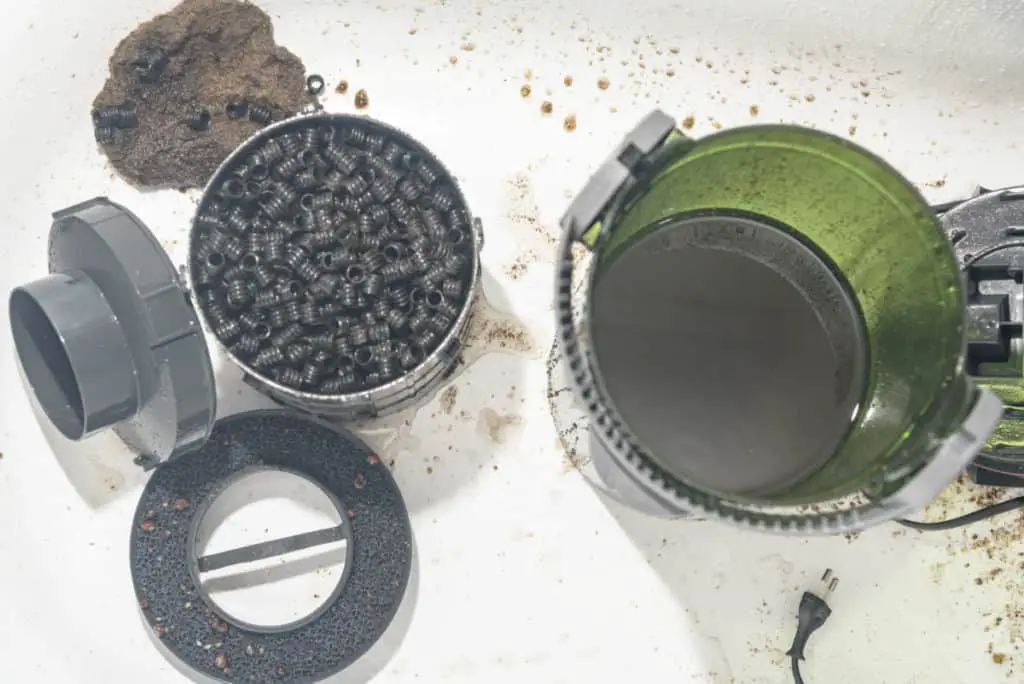
Cleaning filter media
When cleaning your filter media the worst thing you can do is wash it in boiling or even warm water. This is the quickest way to kill the good bacteria that live on and within the media.
How to clean your media.
- Take a jug or bowl of aquarium water from your aquarium
- Remove the filter media from your filter
- Wash the filter media in the jug of aquarium water removing as much debris from the media as possible.
- Throw away the dirty water and add the filter media back into the filter before it dries.
Replacing filter media
No matter how carefully you clean your filter media, at some point it will reduce in performance. This is due to the surface becoming blocked and less effective. If you replace all your media at once you will put your aquarium conditions at risk.
Good bacteria in a fish tank filter can take up to 6 weeks to grow until it reaches optimum performance and capable of coping with the amount of waste your fish product.
- First rule: Never replace all your filter media at once. Do it in stages over a two month period.
- Remove the underperforming filter material and change 75% of the selected media.
- Add the new media to the 25% old media and mix up.
- This will give the bacteria room to spread and grow quickly.
Because you’ve not replaced all the media at once such as the foam inserts, you won’t put your aquarium at risk. The new media may take up to 6 weeks to become fully effective but the existing mature media will keep up the good work until the new media is fully active.
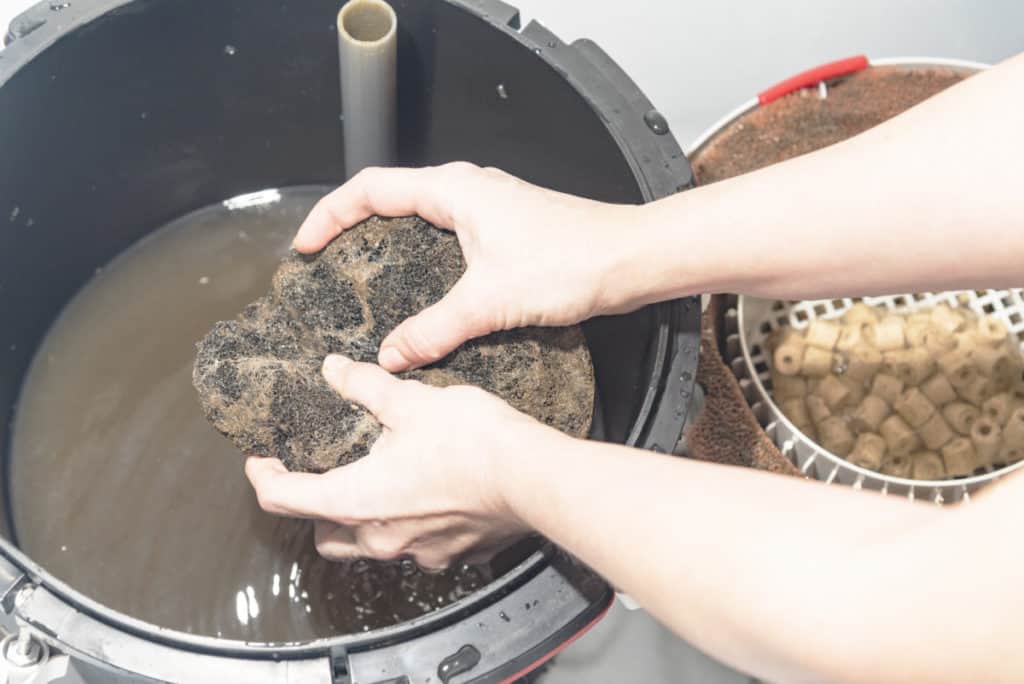
When Should You Replace Bio– Media?
We recommend changing your bio-media every 9-12 months. The performance of the media will reduce month-on-month. Often this goes unnoticed until suddenly there’s a crisis within your aquarium.
Monitoring your water conditions is the only way to keep an eye on the performance of your filter media.
You can also keep an eye on the
Top Tip: Remember, never replace all the aquarium filter media at once. Do it in stages and only change one form of media at a time.
F.A.Q
- How can
bio-media help keep my aquarium clean? Good bacteria will attach to the bio-media and grow. As water passes over the media it will break down harmful nitrite, nitrate and ammonia. - Does bio-media work instantly? No, bio-media will take time to start growing enough good bacteria to start working correctly. This process can take up to 6 weeks.
- What is the water cycle process? The nitrogen or water cycle is the scientific term for the process in which ammonia and nitrites are broken down by bacteria to produce nitrate.
- Will I need any other media in my filter? Yes, you will also need some mechanical media to trap larger particles of dirt.
- How do I clean
bio-media? Use the water from your aquarium to rinse the media. You can otherwise harm or destroy the good bacteria from the bio-media. Should I boil wash my media? Never do this. Washing media in boiling water will instantly kill the good bacteria that took up to 6 weeks to grow. How long does bio-media last? Depending on the type of bio-media you use it can be anywhere from 1 year to 5 years if cared for correctly.
Conclusion: Best Aquarium Bio-Media For Fish Tank Filters
There’s a confusing amount of filter media on the market today but we hope we have cleared up a few concerns you may have had.
Our number one choice would be Biohome Filter material (Affiliate Link) as it was the most effective and competitively priced bio-media we tested.
Most modern bio-media is better than the old fashioned media that I used over 30 years ago. In fact, we often just added a layer of gravel inside our filters which worked but is nowhere near as effective as these modern media.
Those days are long gone, Thank goodness!
- Comparing Aquarium Gravel To Sand – Which Is Best For Your Tank?
- Marineland Magniflow 360 Canister Filter 360 GPH | Pros and Cons
- Best Aquascaping Tools Every Aquarist Should Use
- Best Aquarium Plant Substrate Review 2022
- Polar Aurora Canister Filter | 2022 Updated Review 525 GPH

I have been working in the tropical fish industry for over 30 years now and I’m still learning. Everyday is a school day in this hobby. In my spare time I play golf very badly!


